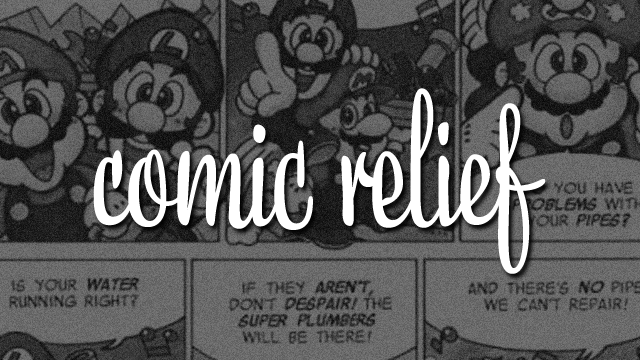 Back in the early days of Nintendo Power, it wasn’t too uncommon to prop open a nice, ridiculously colorful issue and see– right in the middle– a bunch of comics about your favorite video game characters. From Super Mario Bros. to Star Fox to Metal Gear Solid, issues of Nintendo Power past showcased not only some of the greatest heroes of any video game, but also the greatest writers and illustrators. (Nintendo Power‘s editors, that is, didn’t just hire some guy to draw four-panel stick figure comics and call it Mario-related.) Nowadays, it’s pretty hard to find old issues and read those same comics, unless you’re lucky enough to have a cousin who donated his entire collection to you (hah), but if you rub shoulders with enough gamers, you’ll probably still be expected to have read them. No worries! Here’s a primer that’ll help you fight off even the most literate of Nintendo Power readers.
Back in the early days of Nintendo Power, it wasn’t too uncommon to prop open a nice, ridiculously colorful issue and see– right in the middle– a bunch of comics about your favorite video game characters. From Super Mario Bros. to Star Fox to Metal Gear Solid, issues of Nintendo Power past showcased not only some of the greatest heroes of any video game, but also the greatest writers and illustrators. (Nintendo Power‘s editors, that is, didn’t just hire some guy to draw four-panel stick figure comics and call it Mario-related.) Nowadays, it’s pretty hard to find old issues and read those same comics, unless you’re lucky enough to have a cousin who donated his entire collection to you (hah), but if you rub shoulders with enough gamers, you’ll probably still be expected to have read them. No worries! Here’s a primer that’ll help you fight off even the most literate of Nintendo Power readers.
Howard & Nester; Nester’s Adventures
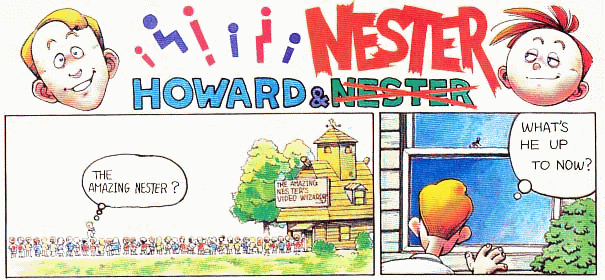
Publication date: July/August 1988 – June 1991 (Howard & Nester); July 1991 – December 1993
Writers/Artists: Unknown, possibly Benimaru Itoh (Howard & Nester); Dan Spiegle (Nester’s Adventures)
Hook: Know-it-all teen Nester (standing in for every other reader of the magazine) stars with then-NOA creative director and NP editor Howard Phillips. Nester frequently finds himself in locales relating to the cover story of each issue, from Ninja Gaiden to Golgo 13: The Mafat Conspiracy, and Howard just as frequently has to bail him out of trouble. Nester, meanwhile, will never admit it.
Why it impressed: Though the original artist is uncredited (Benimaru Itoh, artist of the Super Metroid and Star Fox comics, is a close contender due to his art style), Nintendo showed off just how well-connected it was by having Inkpot Award-winning Dan Spiegle (with a long list of distinguished credits) draw NP‘s beloved mascot, not to mention how far it was willing to go to impress its audience, and in so doing won the hearts of pretty much every reader in town. While Nester hopped along, doing what kids like him did best– that is, experiment with all sorts of ways to beat the games they loved– Howard played the straight man, usually giving perfectly legitimate tips that Nester often overlooked, much to his detriment. At the same time, Nester was so beloved by the NP staff that his name was almost always used in screenshots that the staff took, furthering his adventures beyond that of the simple comic world. Unfortunately (or fortunately), after Howard left the strip in The Lone Ranger, Nester ran the show by himself in Spiegle’s Nester’s Adventures— and then, owing to a certain mustachioed plumber’s extreme popularity, was gradually phased out. His comic was cut down from two pages to one in 1992, and at the end of 1993, NP doled out the worst possible Christmas present to its readers by giving Nester the slip– in essence, ending not only NP‘s childhood era, but also that of its (we assume) highly saddened readers.
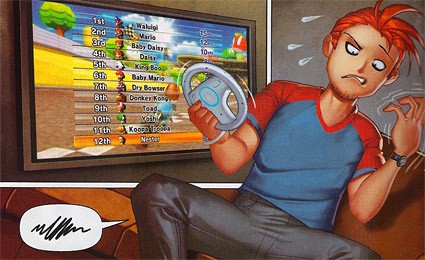
Nester makes a reappearance in the 20th anniversary issue of Nintendo Power, now all grown up with a wife and son.
Legacy: While Howard Phillips has since worked for JVC, THQ, Microsoft Game Studios and his own consulting firm– essentially disappearing off the face of Videogameland, though here’s a nice interview of Phillips with his son Alex– Nester has, well, pretty much disappeared too. In 1996, he did show up in Nester’s Funky Bowling, a Virtual Boy game, and in the same name appeared in Pilotwings 64 under the name Lark. Aside from the odd tribute in the modern Nintendo Power, though, Nester is all but forgotten– unless, of course, he’s been the guy who’s been submitting those Nester64x columns all this time. (It would make sense, we guess.)
Where to Find it Now: The Howard & Nester Comics Archive (Wayback Machine)
Battletoads
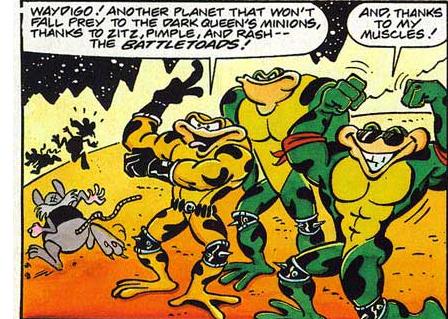
Publication date: May – June 1991
Writer/Artist: Guy Miller
Hook: Dave, George and Morgan may seem to be ordinary video game testers, but when they’re transported into Vidspace through a certain Dr. Silas’ transporter, they turn out to be quite the toads– literally. Televised to an audience, the Battletoads’ adventures make them very famous, causing a jealous Silas to modify the transporters to change the three into toads permanently. Fortunately, they kind of like being amphibious war machines, and start kicking all sorts of butt.
Why it impressed: If your parents never let you read Batman or Spider-man comics, Nintendo Power‘s comic on Battletoads was probably the closest you’d ever get. Guy Miller, a graphic artist with Rare at the time, certainly wasn’t a professional comic book artist (or writer) by any means, but the very fact that the guy who designed the Battletoads game deigned to write and draw a comic for Nintendo Power was very cool. And unlike most other comics that Nintendo Power had shown or would show, the Battletoads comic wasn’t just a retread of the game– in fact, Miller’s comic is considered a canonical prelude to the actual game. And besides, how can anyone not love a comic that uses an expression like “What the frog?” in all earnest?
Legacy: Battletoads is and was a pretty tough game, and though it spawned a number of sequels (no pun intended), Rare has all but abandoned the franchise in favor of things like, uh, Viva Piñata. Meanwhile, Guy Miller went on to become the creative director of Electronic Arts’ games based on the Harry Potter franchise, though rather abruptly left the game industry in 2008.
Where to Find it Now: Error Macro
Super Mario Adventures
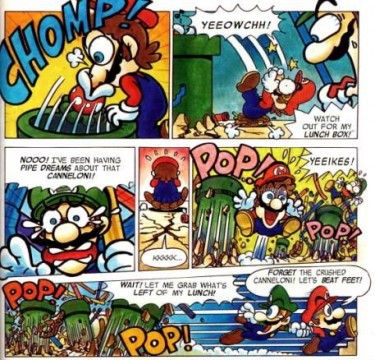
Publication date: February 1992 – January 1993
Writer: Kentaro Takekuma
Artist: Akira “Charlie” Nozawa (a.k.a. Sakura Tamakichi)
Hook: Mario and Luigi show off both their plumbing, costuming and Goomba-stomping skills (not necessarily in that order) in some of the most entertaining (and well-illustrated) comics this side of the Pacific Ocean. Guest stars: Toad, Princess Toadstool, Yoshi, Bowser and the Koopa Kids (!).
Why it impressed: It’s one thing to basically take a game and illustrate it, as future comics did (Metroid Prime, I’m looking at you), and when it came to its burgeoning Mario franchise, Nintendo could very well have just hired some hack artist to do exactly that. Instead, Nintendo asked Akira Nozawa (credited as Charlie Nozawa), then a young illustrator best known for writing and drawing gag manga for MSX Magazine, Famitsu and (best of all) NES instruction manuals, to work his magic on Nintendo’s best-known character, with Kentaro Takekuma (known in Japan for the satirical Comic Lesson: Even an Ape Can Draw a Comic) creating the scenario. In response, the duo took the very essence of Mario and Luigi– that is, uber-lighthearted, determinedly simple gameplay– and applied it to their comics. From Mario & Luigi trying to peddle their plumbing wares door-to-door (and only somewhat succeeding) to Luigi’s very progressive clothes-switching with Princess Toadstool (it was so that Toadstool could escape unscathed, but nevertheless), Takekuma and Nozawa made sure both children and the odd adult Nintendo Power reader alike would enjoy Super Mario Adventures. This is an even greater achievement when realizing that the two could have very well just had Mario stomping on Goombas all day long and justify it by saying it’s faithful to the series. The formula that Takekuma and Nozawa ended up actually using, then, is one that Shigeru Miyamoto himself would be proud of, and one that Shigesato Itoi (Mother, Earthbound, too many novels to count) himself praised.
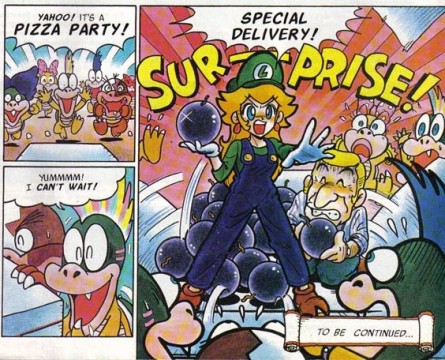
Legacy: Obviously, Mario and Co. have found themselves subject to a whole lot of new games, and games like Mario and Luigi: Superstar Saga as well as its sequels have propelled the crew to new levels of hilarity. However, the one who illustrated Mario’s first foray into comic history– Charlie Nozawa– has all but disappeared, at least from the West. According to his Japanese Wikipedia page (his English one is pretty empty), Nozawa did some character design for rather obscure PC games, as well as illustrations for a few lad mags, and now illustrates advertisements for various businesses. Mario, it seems, is no longer on his agenda. Takekuma, for his part, has done various interview books, as well as some of his own original manga series.
Where to Find it Now: Ebay (for trade paperback); The Koopatorium
The Legend of Zelda: A Link to the Past
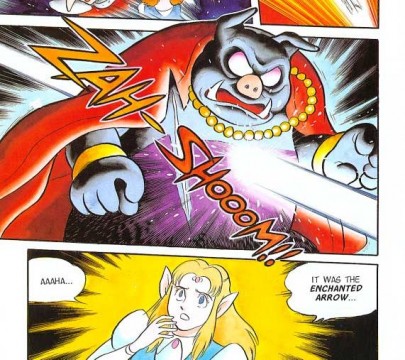
Publication date: January 1992 – December 1992
Writer/Artist: Shotaro Ishinomori, trans. by Dan Owsen
Hook: After being called to action by the telepathy of Princess Zelda herself, Link seeks to not only save the princess, but also find the truth behind his parents’ death. He’s helped along the way with both characters that show up in the game (Sahasrahla, his uncle) and ones that don’t (Roam, Ephmerelda).
Why it impressed: So while it’s pretty cool that Howard and Nester and Nester’s Adventures got people like Dan Spiegle to work on the comic, author and illustrator Shotaro Ishinomori takes the proverbial Master Sword on this one. Ishinomori, who passed away in January 1998 of heart failure, was the creator of Kamen Rider and Super Sentai— you probably know those as Masked Rider and Power Rangers— and widely known as the father of the transformation-superhero, or henshin, craze that continues to rock the world. (Viewtiful Joe, anyone?) Like with Super Mario Adventures‘ Charlie Nozawa, the A Link to the Past comic benefited tremendously with Ishinomori’s refusal to stick exactly to the plotline. Link, for instance, is helped out by a suspiciously Navi-like fairy named Ephmerelda, and meets another prospective Triforce-wielder in the Dark World named Roam. And by the last page of the comic, all that unresolved sexual tension between Link and Zelda that fans both enjoy and bemoan is certainly resolved– though probably not in the way that anyone might expect. As for the art, it’s definitely more serious than anything Nintendo Power had run until that point– probably in no small part due to Ishinomori’s virtuosity– and in fact provided a nice parallel to Super Mario Adventures, which ran mostly parallel to the Zelda comic. Most of all, Ishinomori provided a definitive, though non-canonical, story to players hungry for more Zelda action that they wouldn’t have until 1998’s Ocarina of Time.
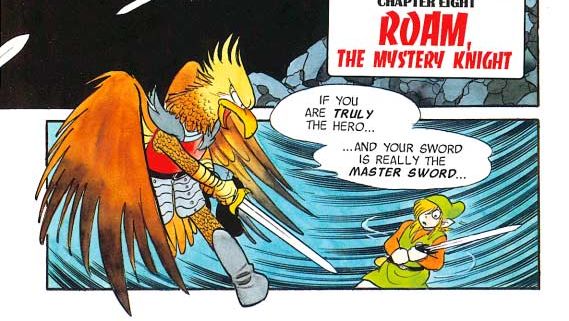
Legacy: Six years after publishing A Link to the Past, Shotaro Ishinomori passed away of heart failure, but not after passing on his beloved Skull Man comic to Kazuhiko Shimamoto, who has since propelled it to a seven-volume series (up from a hundred-page one) and a full-length anime series. And while Nintendo Power published The Legend of Zelda: A Link to the Past as a trade paperback (this author vividly remembers wanting to purchase it as a child but being rebuffed by his mother), it’s since gone out-of-print. Fortunately, Akira Himegawa has since illustrated and written a number of The Legend of Zelda manga volumes, and three years or so ago Viz Media started to localize them in English. If you’re looking to buy Zelda comics, those may be your best bet.
Where to Find it Now: Ebay (for trade paperback); Rauru’s Return
Mario vs. Wario
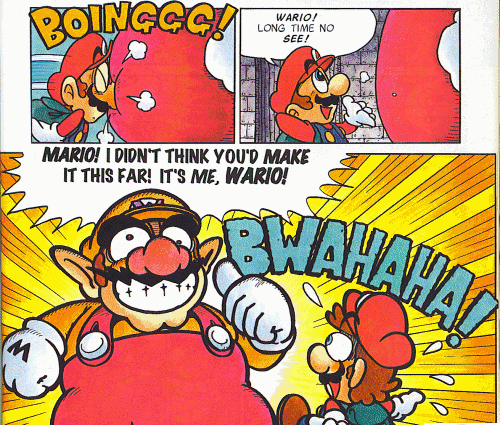
Publication date: February 1993; February 1994
Writer: Kentaro Takekumi
Artist: Akira “Charlie” Nozawa (a.k.a. Sakura Tamakichi)
Hook: Jealous of Mario’s success in Super Mario Adventures, Wario tries to butt in on Mario’s life, blaming him for all of his life troubles. Mario, for his part, is totally oblivious that he’s ruined Wario’s life.
Why it impressed: Essentially, Mario vs. Wario is a spin-off of Super Mario Adventures— it even has the same writer and artist working on it. And of course, it’s just as hilarious and creative. This time, Takekumi and Nozawa explore the absurdities of Super Mario Land 2: Six Golden Coins for the Game Boy, as well as what might happen if the Princess invited both Mario and Wario to her birthday party. (Apparently, in Takekumi and Nozawa’s world, Mario and Wario are the best of buds– or at least, Mario thinks so.) Though they’re just one-shots, compared to Super Mario Adventures‘ sprawling storyline, that’s exactly what the two Mario vs. Wario strips are supposed to be, and they’re still worthy reads.
Where to Find it Now: Ebay (for trade paperback); Yoshi Art
Star Fox
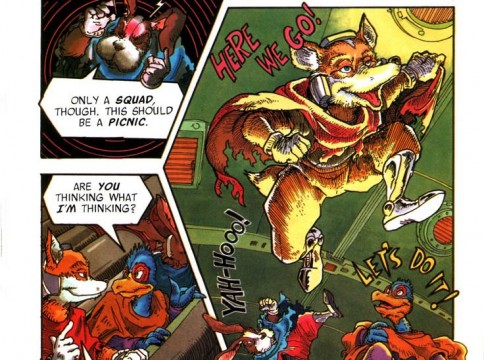
Publication date: March 1993 – January 1994
Writer/Artist: Benimaru Itoh
Hook: Long after his father disappears and his mother dies in an explosion, Fox “Star Fox” McCloud sets off on an adventure to fight off Emperor Andross and his Imperial Lizards, joined by Peppy Hare, Falco Lombardi, and Slippy Toad– and inevitably runs into a few family problems.
Why it impressed: Star Fox may have been technically powerful for its time, but that probably undermined much of its storyline– players likely were paying too much attention to Argonaut’s masterful use of the SuperFX chip to pay attention to the game’s storyline. Fortunately, Benimaru Itoh wrote and drew a Star Fox comic for Nintendo Power, and though it’s non-canonical, it certainly illustrates a perspective on the Star Fox universe that likely would not be there otherwise– especially considering the characters that Itoh added. Whether it’s Fara Phoenix– Fox’s love interest before Krystal ever showed up, and a character in the ill-fated Star Fox 2— or Slippy’s unnamed girlfriend, not to mention Fox’s oft-forgotten mother, each character adds depth to a storyline otherwise just about shooting down aliens and monkeys. And besides, it’s just fun to see Fox and Co. jump around in tattered Star Wars-esque robes. (And see Andross talk about his foster parents. Who were robotic pigs.)
Legacy: Star Fox hasn’t been explored in American comics since Itoh’s Nintendo Power foray, though there are plenty of fan comics. Nintendo of Europe, though, did commission its own take in honor of Star Fox 64, though most Star Fox comics, much like the Star Fox series itself, have gone the way of the dinosaur planet.
Where to Find it Now: Arwing Landing
Super Metroid (Volume 57-61)
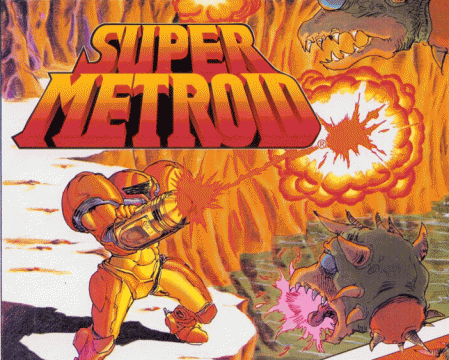
Publication date: March – July 1994
Writer/Artist: Benimaru Itoh
Hook: After her Baby Metroid is stolen by Ridley, Samus follows the alien back to Zebes, where everything began. This time, though, she’s got personal issues with the Space Pirates (even moreso, that is), as well as friends such as Armstrong Houston (who uses a variant of Samus’ suit) and her foster father, Old Bird.
Why it impressed: A lot of people like to talk about how Super Metroid, despite its sparseness in terms of explicit storytelling, tugged at their heartstrings just by including the Baby Metroid (and its inevitable fate). While this is true, and also suicidal to argue against (people really like their Baby Metroids), Super Metroid— and most Metroid games, even in the present– don’t really discuss Samus’ background in any wider context. Itoh, on the other hand, introduces a story hot on the heels of his Star Fox comic that continues the themes of family and friendship. Itoh introduces such memorable characters as Armstrong Houston, in a way apparently Samus’ biggest fan (though he would never admit it), complete with matching Varia Suit, as well as Samus’ foster father, Old Bird. (Old Bird, in fact, is the source of much of Samus’ history that is revisited in games like Metroid Fusion and Metroid Zero Mission.) Itoh’s Super Metroid, for its time, was more than a graphical walkthrough of the SNES game. It was a compelling adventure through Samus’ own history, and one that filled a gaping void that would not be further satiated until Samus returned in Fusion and Prime.
Legacy: Though Samus has since returned time and time again in comics and games, Itoh, like so many of his fellow Nintendo Power contributors, has not. According to his Wikipedia site, though, as well as IMDb, Itoh was on hand for Super Smash Bros. as staff and source modeling chief for the Pokémon Stadium level. He also illustrated Bulbasaur’s Trouble in the Pokémon Tales series of children’s books.
Where to Find it Now: Metroid Database
Metroid Prime
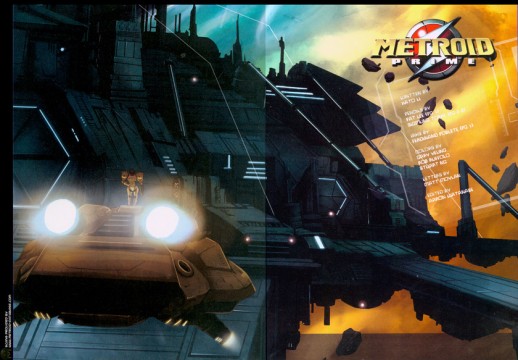
Publication date: January – March 2003
Writer: Kato Li
Pencils: Pat Lee (page one), Sigmund Torre
Colors: Gary Yeung, Alan Wang
Hook: Samus receives an SOS from the frigate Orpheon, and investigates only to be fought off by a new Meta Ridley. Following him, Samus lands on Tallon IV and begins to investigate a strange new substance– Phazon– as well as its effects on both Tallon IV’s native creatures and the Space Pirates’ research.
Why it impressed: According to Nintendo Power, the Canada-based Dreamwave Productions leapt at the chance to do a Metroid Prime tale, and though it’s only two issues long, their dedication shows. Nine years after the last Nintendo Power comic (except for a few non-exclusive outliers– see “Other Comics”, below), the Metroid Prime comic probably made a lot of people happy despite its rushed storyline, simply because it’s so darn pretty. Sigmund Torre (and Pat Lee, if we’re talking about the first page) draws with a clear, uncluttered hand, which is very much welcomed when you’re adapting a game like Metroid Prime. And though there’s admittedly not much in terms of story, anyone who’s played Metroid Prime should feel like they’re coming home as they read the rather action-packed issues. But nevertheless, Metroid Prime has come a long way since the last exclusive Nintendo Power comic– perhaps due to space constraints or time issues, it apparently was impossible to stretch out the storyline just a little longer.
Legacy: Nintendo Power hasn’t released much lately, and neither has Dreamwave Comics– in fact, on January 4, 2005, Dreamwave Productions shut down completely. At that point, other than Metroid Prime, Dreamwave had worked on a Transformers comic series, as well as original series Darkminds and Warlands. Pat Lee, co-founder of Dreamwave Productions, went on to work for Marvel and DC, though he’s also had his fair share of controversy. At least Samus is doing well for herself!
Where to Find it Now: Metroid Database
Other Comics
Nintendo Power also excerpted some comics that aren’t here simply because they were first published elsewhere, and were not published exclusively for Nintendo Power. These include an excerpt from Star Wars: Shadows of the Empire (October 1996 – February 1997), Blast Corps (February – April 1997), Custom Robo (October – December 2004), Metal Gear Solid – The Twin Snakes (May – June 2004) and Pokémon Mystery Dungeon: Ginji’s Rescue Team (September 2006 – February 2007). Meanwhile, Pokémon: TV Animation Comic and Kirby: Right Back at Ya! were not included because they were essentially each television series boiled down to a series of comic book panels– which are interesting in their own right, but not exactly original. They’re still fun to read, though, especially if you don’t feel like taking thirty minutes to watch a single episode.
Nintendo Power‘s published a lot of comics over the years, though now that Future’s publishing the magazine, there haven’t been many– or any, rather– comics lately. If Itoh’s, Ishinomori’s and Ozawa’s work is any indication, though, this is a pretty big shame. What are your favorite comics? And how much money would you pay Nintendo to start their whole comic shebang up again?




 ShareThis
ShareThis






